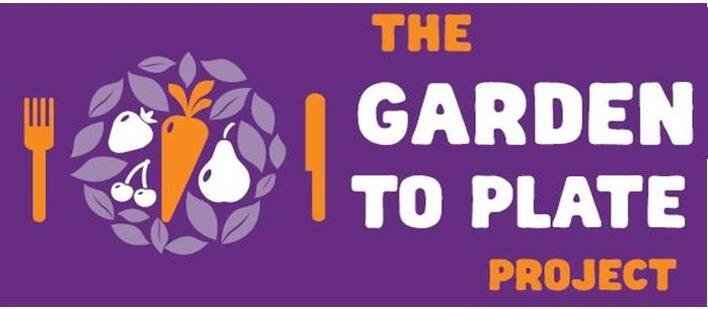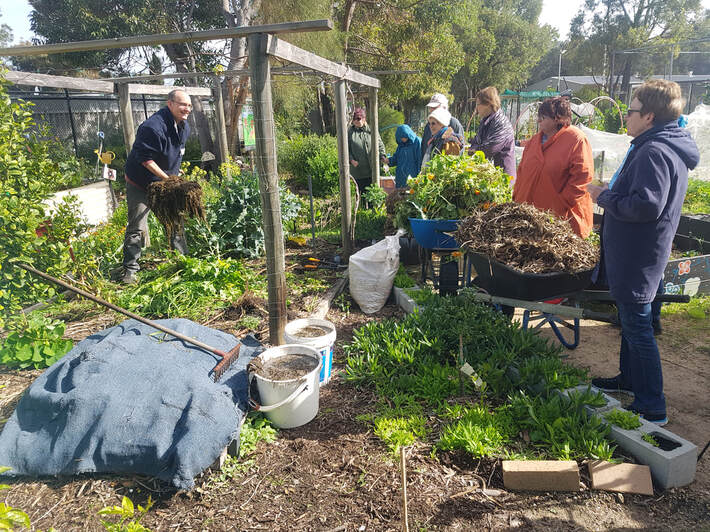News |
from Mandurah Community Gardens
News |
  Garden 2 Plate Facilitators: Nicole Ingham (Foodbank WA Nutritionist) & Chris Lampard (Mandurah Native Gardens). Guest Speaker: Ellen (Byford Community Gardens) Written by: Pauline Soucie Garden to Plate is an innovative project running since 2014, that focuses on improving health and encourages people to become more involved in their local community - for more information follow this link: https://www.foodbankwa.org.au/2014/06/20/garden-to-plate/ Foodbank WA (fighting hunger in Western Australia since 1994) have partnered up with the Mandurah Community Gardens and the City of Mandurah to offer these fantastic free community courses, where participants learn about the value of including fresh fruits and vegetables in their diet and are armed with information & resources aimed to help them growing edible gardens at home. Once you get a taste for growing food organically, it becomes such a satisfying and rewarding experience, to harvest your own food and enjoy the nutritional and taste benefits. You will never want to buy “fresh” fruit & veg from supermarket chains like Coles or Woolworths again…and hey just think how many plastic bags you will save in the process! Today’s topic was all about SOIL… the importance of building healthy soil for happy plants. Oh and did I mention Nicole made yummy homemade soup plus fruit and other tasty treats from the garden?? All free and delicious I might add! (on a side note; Nicole also runs an AWESOME community cooking course called Food Sensations through Foodbank WA which is also free! To find out more &/or book on an upcoming series, email [email protected]). As an informal “icebreaker” we mingled to introduce ourselves, describe our favourite vegetable, plus name a vegetable that we’ve never tried before (seems artichokes won the ‘never tried’ award, but not everyone agreed they’d like to try eating one haha). Then it was game time: Name that Vegetable (to be followed up with “Eat that Vegetable” – a take home challenge to try every vegetable listed before next month’s workshop). Given most of us are pretty keen gardeners I think everyone breezed through the naming game – however it would be interesting to see how well kids and/or say, staunch pie eaters would go identifying approx. 25 different types of vegetables by (unpacked) pictures alone. Which leads me to question: how in touch “we” are with our food these days? The more immersed I become in gardening & learning about organic growing methods, the more I realise how out of whack & disconnected from food our society in large has become. In my own experience, just a few years ago, I actually would not have been able to tell you how a lot of fruits & vegetables grow (for instance pineapples! Oh and how about peanuts?! P.S. if you don’t know, google it yo) - let alone giving much thought as to where the produce I was buying came from (i.e. if something is not the season for growing but it's available to buy, chances are it’s not local and therefore not as good - but hey that is another blog topic in itself me thinks). Especially true in remoter areas (such as Karratha, WA) where as a local for several years I had just figured the only smart option was to buy snap frozen vegetables wrapped in plastic bags…something that nowdays you would rarely - if ever - catch me eating that frozen mushy crap! Yup, now I eat straight from the plant if I’m hungry in the garden and WOW is it good! Many people question why bother growing their own food - and hey I get it - in this fast paced consumer driven "convenience" bandwagon the world has become stuck on, we have almost lost the ability to survive should society as we know it collapse. Seriously though, it’s not that hard to break free from that kind of consumerism mentality! I suggest to start small, with stuff you like to eat, choose easy to grow crops based on your location, lifestyle (and cooking styles) – whatever works, go with that, start there & see what happens! It’s good for the soul to run a little wild with nature every now and then, feel the sun on your face (okay pretty hit or miss this time of year I will admit), embrace the beautiful bees & bugs, get your hands dirty, feel the soil and get that earth connection. I promise the more you seek, the more you will be amazed! Meanwhile back to why good soil is important… Healthy soil = better tasting, healthier plants with more nutrients (and no nasty chemicals and pesticides!) By putting more effort into the prepping the soil’s biology, you will also find less need to “feed the plants” because you have a network of microbial organisms teaming up to work for you and your beautiful plants. Using these techniques combined with crop rotation & effective composting methods you will not only get bumper crops, but will extend the life-cycle of your garden bed (this means less work in the long run!). Ellen (from Byford Community Gardens) spoke about Soil Biology, organic gardening principles, biological planting to feed microbes/micro-organisms & explained how all these elements make up the ‘Soil Food Web’. Fun Fact: Grasses harbor Bacteria; Trees love Fungi – but Vegetables need a blend of both, held together in harmonious balance by Nematodes (these act as a delivery system for nutrients). Next Chris dished the dirt on Composting & worm farming (check out his great visual below to explain to the process if you're more of a picture person) DIY is always best when it comes to composting because it's literally ALIVE with organic matter. Not only is composting and worm farming super fantastic for the soil biology but it's so affordable, practical & will cut down your household waste! Think WIN WIN! Compost piles LOVE a feed of worm wee/poo "teas" (not to be confused with a cuppa tea hahaha) – and again, the DIY approach will produce maximum results and is affordable and easy (however brewing compost & worm teas may also need a blog of its own). Using whatever ‘ingredients’ you have available and a few simple new household habits, it won't take long to get your compost festering along nicely... So, the two main types of composting discussed today were Sheet Mulching and "Insitu" Composing: Sheet Mulching (based on permaculture principals) So this is a super easy and affordable way to start, however consensus seems to be split on the effectiveness, especially if you're talking about areas typically infested with grass or weeds. The process basically entails mowing the lawn area or removing the weeds then smothering with thick layers of cardboard - just be careful not to leave any gaps else may find weeds/grasses escaping through to your garden bed later down the track. If you really wanted to be sure your weeds die and don’t come back, you could go hard and dig out the grasses or if you have the time/money to spray, try a glycosate based product (however I highly recommend keeping the chemicals away from anything edible and if spraying chemicals allow several weeks before preparing the affected area). "Insitu" Composting (chop and drop method) This is by far Chris' preferred method (and hey if you have the time and space it really doesn't get any easier than this!) It's all about layers and using available organic materials to prep an area you would like to set up as a vegetable garden in the future. Start with a layer of green manure for Nitrogen (oats, peas, vetch & mustard are some of the most nutrient dense but you can use lawn clipping or any other clean green waste), then a layer of brown matter for Carbon (sawdust, woodchips, straw etc). Next is a lovely layer of poo (worm poo wins hands down but sheep & chook poo are also effective), another layer of green materials, another brown layer then heavily cover with mulch and give a big 'ol drink before covering up that badboy with a carpet to keep all those stinky juices warm and contained. Leave to stew for 1 month then smoosh it all around with a pitch fork and leave 1 more month...and then voila...you have made compost! Spread the resulting black gold around and hey presto it's time to sow some seeds. Most Mandurah local gardeners know from experience, that our soils are typically sandy, with little to no nutrients or water retaining capabilities. So Chris finished up by answering the question on everyone's lips...how do I turn my sandy, water-proof dust bowl into a lush organic haven for microbes and such?? SANDY SOIL REMEDY FORMULA Bentonite Clay (2-3kg) Compost (20L) Manures (10L) Minerals like Rockdust (few scoops) Wetting Agent (handful) Worm Castings (1/2 bucket) I'd just like to add in closing, that it has been a massive blessing meeting & joining the passionate team at Mandurah Community Gardens and plugging into a wonderful wealth of knowledge (& plant) sharing. With so many exciting workshops and events happening this year, I won’t blame you for being interested or wanting to get involved! If you want o know more &/or become a member email: [email protected] |
Categories
All
Archives
June 2024
|
